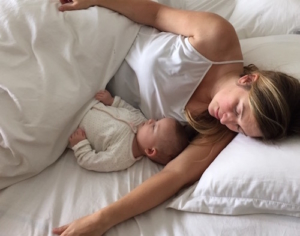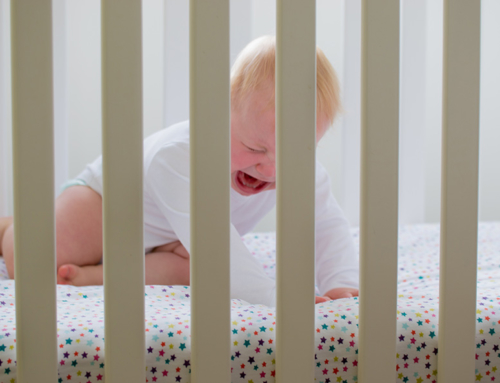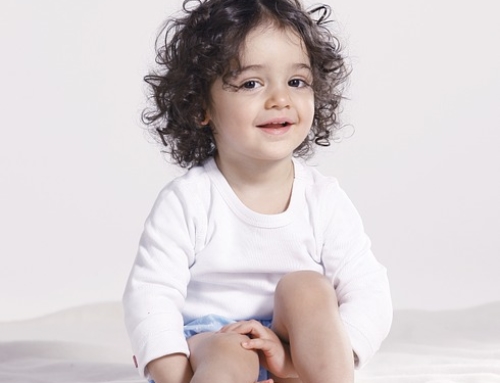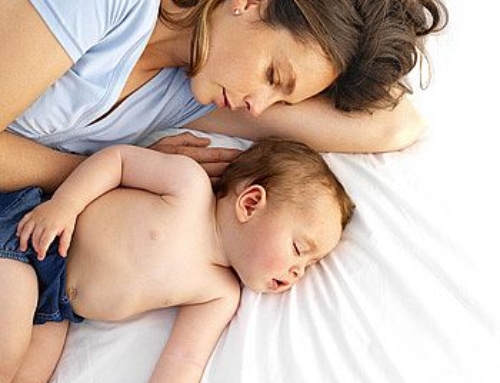The American Academy of Pediatrics (AAP) has released their updated Safe Sleep Guidelines
A bit of background
In the United States approximately 3500 infants die each year from Sudden Unexplained Death of an Infant (SUDI) (which includes SIDS and “ill-defined deaths”) and accidental suffocation or strangulation in bed. This number has not really changed in over 20 years and this has prompted many researchers and epidemiologists to search for answers as to what factors may be modifiable in a bid to try and decrease this number even more. This is why you have seen ads against bedsharing – it has been deemed a “modifiable risk factor” and one the AAP and other health agencies have attempted to tackle despite newer research suggesting it is not as clear-cut that bedsharing per se (as opposed to unsafe bedsharing) is a risk factor[2][3], especially not at all ages[4]. With this in mind, the AAP Safe Sleep Task Force reviewed the research again to come to their new conclusions which comprise this 2016 Technical Report.
The recommendations
The new recommendations are given for infants up to 1 year of age and each recommendation has its own “strength” based on the evidence provided. A-level recommendations are those with good-quality research, B-level ones have inconsistent research, and finally C-level ones being based on discussion and consensus. A lot of the recommendations are about future research, who should partake in talking to families about sleep, and the use of commercial items that aren’t in line with these guidelines. However, let’s look at the actual A-level guidelines, one by one (in order given by the AAP):
- Back to sleep for every sleep. This is the same as 2005 and should be no surprise given that it was this campaign that led to the drastic reduction in SIDS-related deaths in the 1990s and this recommendation includes this even for most babies with gastroesophageal reflux (GERD) (exceptions of certain upper airway disorders are listed by the AAP). Notably they also speak out against raising the head of an infant crib for GERD for risk of baby sliding to the foot of the crib and one study found it did not help. Of course, this recommendation would mean no baby could sleep in a wrap on a caregiver and that wouldn’t make a lot of sense for those of us babywearing. And there’s good reason for your baby to sleep on you as contact during sleep (and motion from the caregiver moving around) can help calm baby and result in deeper sleep as well as allowing parents to note hunger cues and so on[5]. However, a baby sleeping on his or her caregiver’s chest for a nap in a wrap is not face-down, but should be in a position where the caregiver can monitor breathing and ensure that baby is not up against the carrier or wrap in any way. Check your carrier guidelines for assistance on this.
- Use a firm sleep surface. This is not new and part of safe co-sleeping guidelines as well. Soft surfaces are dangerous for babies because they can sink in and are unable to move themselves away from any bedding. This guideline includes types of bedding as well as things like duvets and quilts should not be used nor should soft mattress toppings or mattress covers. A human being can be a “soft surface”, but this is why a baby should always be in a position where breathing is clear and not up against any skin. Again, see safe sleep recommendations in your given carrier or wrap.
-

Source: MomJunction
Breastfeeding is recommended. Breastfeeding has been recommended by that AAP, but never quite this clearly. In this report, they are clear that exclusive breastfeeding for 6 months is recommended to protect against SIDS although any breastfeeding has been found to be more protective than no breastfeeding. The meta-analysis used for this recommendation[6] found that the multivariate odds ratio for any breastfeeding at any time point on “protecting” against SIDS was 0.55, the univariate summary odds ratio for any breastfeeding at 2 months was 0.38 and for exclusive breastfeeding was 0.27. What do these numbers mean? If we view breastfeeding as the biological norm that it is, the relative risk of any formula use is 0.65 (out of 100 infants who die of SIDS, 65 will have had formula), of formula use at 2 months, the relative risk is 0.72 (out of 100 infants who die of SIDS, 72 will have had formula at 2 months), and of not exclusive breastfeeding, the relative risk is 0.79 (out of 100 infants who die of SIDS, 79 will have been exclusively formula fed or mixed fed whereas 21 will have been exclusively breastfed). On a population level, these are huge numbers and one reason why so many people are attempting to help support breastfeeding and women’s choices to breastfeed.
- Room-sharing with the infant on a separate sleep surface is recommended. Room-sharing was recommended in the 2005 report, but this report makes more specifications. Although bedsharing is still spoken out against, this report makes clear the infant separate sleep surface should be close to that of the parent and mentions the use of in-bed products or bedside sleepers to make bedsharing safe. The AAP does not speak out in favour of or against these products because research is lacking on them, but does mention them as options families may consider. The AAP is also clear that surfaces such as sofas and armchairs are incredibly dangerous and should be avoided and are more dangerous than an infant falling asleep in an adult bed. This is actually good because too many people, in an attempt to avoid bedsharing, end up falling asleep on an armchair or sofa with catastrophic results. They also mention the specific risk factors for bedsharing – the first time they have acknowledged that certain factors are specific to bedsharing – although they still suggest bedsharing should be avoided full stop.
- Keep soft objects and loose bedding away from the infant’s sleep area. These recommendations are in line with previous ones and known research on the risk of soft objects and bedding for infants. Of note, the AAP mentions that parents should be avoiding bumper pads in cribs because newer cribs that conform to standard do not pose the risk of head entrapment, but bumper pads are a known suffocation risk. (Which makes me ask why we even allow them on the market!)
- Consider offering a pacifier at naptime and bedtime. This is a new recommendation based on research coming out in the last few years showing a large decrease in SIDS with pacifier use during the night. This can be contentious area because early pacifier use has been linked to a reduction in breastfeeding, thus the AAP recommends that breastfeeding be established before pacifier use is introduced in line with research that this is the ideal timing[7]. The authors suggest the mechanism is unknown, but given that the pacifier is a substitute breast and not breastfeeding increases the risk of SIDS, it is worth mentioning that pacifier use may not be at all beneficial for families who nurse on-demand throughout the night. There is no research on this particular subgroup, but as the breast itself provides the same suckling that a pacifier would, it is logical to assume that replacing breastfeeding on demand with a pacifier would not be recommended.
- Avoid smoke exposure during pregnancy and after birth. This is a large risk factor for SIDS and becomes even larger when the family bedshares. Thus avoiding smoke at all times is a modifiable risk factor that deserves more focus, especially given the health implications for the smoker and those around him/her; however, I would argue that we don’t have nearly enough support or help for families to do this. Smoking is highly addictive and many of the over-the-counter aides are not successful. If we are to create smoke-free homes (yes, it’s not just the pregnant mother who should abstain), we need more support and I would have liked the AAP to put in recommendations about how to achieve this.
- Avoid alcohol and illicit drug use during pregnancy and after birth. Avoiding alcohol after birth is touchy as this is one thing that can lead to the reduction in breastfeeding rates. However, when it comes to the overuse of alcohol or illicit drugs, it is a known risk factor for bedsharing sleep-related deaths through the use of reduced arousability. However, the research cited and the research I have read does not suggest the occasional glass of wine or drink by a breastfeeding mother should be frowned upon provided it is taken long enough before bedtime to not pose a risk to arousability at night.
- Avoid overheating. This is a topic that is finally getting attention, though as pointed out by the AAP, there are no clear guidelines for overheating and thus conclusions as to what it constitutes are lacking. Studies that have included tog value in bedsharing research have found high tog values associated with huge increased risk for SUDI. The same goes for wrapping infants too much in their own sleep space. It would have been nice if this report covered some of the important things to look for, such as tog value of any bedding and the use of hats for sleep (they retain heat and can cause overheating quickly even with lower tog bedding).
- Pregnant women should seek and obtain regular prenatal care. Yes, SIDS risk is lower in women who receive regular prenatal care. It would be nice if the AAP actually mentioned the barriers to regular prenatal care that many families face in the United States with recommendations on how these women can obtain prenatal care. This should be a modifiable risk factor, but at the moment, with the current state of health care in the US, I’m not sure it is.
- Infants should be immunized in accordance with AAP and CDC recommendations. Contrary to what a lot of people believe, there is no research that has found an increased risk of SIDS with routine vaccination. Many people point to places like Japan who have a different vaccination schedule and lower SIDS rates than the US as evidence of a potential link. This ignores that (a) Japan still has early vaccination periods, as do other countries like Finland with lower SIDS rates, and (b) that there are other factors that are different between the countries that may account for lower SIDS rates. I have always maintained that vaccination – and the schedule by which it is done – is an individual choice that families must make, but they must make it with evidence. The evidence we currently have is that vaccination either has no role in SIDS or potentially lowers the risk of SIDS.
There we go, these are the big recommendations outside of ones to do with the manufacturing of certain items. The only other one worth mentioning is that swaddling was not found to be a practice that reduced SIDS based on consensus (level C recommendation). You can read more on swadding here: https://www.isisonline.org.uk/sleep_health/sleep_aids/swaddling/ .
Does this mean it is the final say on the research?
Absolutely not. Other medical bodies can and have read the same research the AAP does on many matters (ahem, circumcision) and they reach different conclusions. This happens because of the cultural bias that each nation has about certain parenting practices. In the United States, for example, there is a large push towards independence and in that framework, bedsharing is deemed “inappropriate” and this can colour the reading and interpretation of research. However, they are probably a good starting point for discussion, but anyone should also look at how other cultures interpret this research and the messages given to families.
What is the take home message?

Source: ISIS Co-Sleeping Image Archive
Here’s the issue with these sleep recommendations: They don’t reflect the reality for many families. As always, putting up “the ideal” ignores the many issues families face with respect to sleep. Many infants won’t sleep in a crib, instead requiring contact with an adult. Many infants won’t comfortably sleep on their back and instead do better in a prone, or stomach, position. There’s little support for families in the early months in the United States and this results in tired parents making risky decisions or lacking help with things like quitting smoking or getting appropriate care.
These recommendations are based on looking at sleep in a vacuum and sleep does not occur in a vacuum. Sleep is not just something you can look at recommendations on and then implement and all will be well. Sleep is influenced by culture, parenting beliefs, child temperament, work schedules, family support, child health, and education, amongst others. Instead of a list of recommendations that seem as if each is as modifiable and important as the next, I would prefer to see the AAP provide the numbers for these recommendations, the limitations of these studies, and then a discussion of the other factors that would influence that particular factor. Recommendations are never one-size-fits-all, especially when it comes to sleep, and thus doctors and other medical professionals who work with families should be encouraged to take an individualized approach. Unfortunately, these recommendations don’t give doctors the tools to do just that.
________________________________
[1] Task Force on Sudden Infant Death Syndrome. SIDS and Other Sleep-Related Infant Deaths: Updated 2016 Recommendations for a Safe Infant Sleeping Environment. Pediatrics 2016; full text available at: http://pediatrics.aappublications.org/content/early/2016/10/20/peds.2016-2938 [2] Blabey MH, Gessner BD. Infant bed-sharing practices and associated risk factors among births and infant deaths in Alaska. Public Health Reports 2009; 124: 527-34. [3] Vennemann MM, Bajanowski T, Brinkmann B, Jorch G, Sauerland C, Mitchell EA. Sleep environment risk factors for Sudden Infant Death Syndrome: the German Sudden Infant Death Syndrome study. Pediatrics 2009; 123: 1162-70. [4] Carpenter RG, McGarvey C, Mitchell EA, Tappin DM, Vennemann MM, et al. Bed sharing when parents do not smoke: is there a risk of SIDS? An individual level analysis of five major case-control studies. BMJ Open 2013; 3: e002299. [5] For a full discussion, please see the Infant Sleep Information Source summary here: https://web.archive.org/web/20161105130943/https://www.isisonline.org.uk/sleep_health/sleep_aids/slings/ [6] Hauck FR, Thompson JMD, Tanabe KO, Moon RY, Vennemann MM. Breastfeeding and reduced risk of sudden infant death syndrome: a meta-analysis. Pediatrics 2011; 128: 103-110. [7] Eidelman AI, Schanler RJ. Section on Breastfeeding. Breastfeeding and the use of human milk. Pediatrics 2012;129: available at: www.pediatrics.org/cgi/content/full/129/3/e827





Hi,
In point #3, second last sentence, should it say ‘exclusive formula feeding’ (not breastfeeding) for a relative risk of 0.79?
Thanks.
It’s not exclusive formula feeding, but it should have read “not exclusive breastfeeding” which is now updated! Thank you 🙂
Interesting report SIDS must be on every parents mind, at one stage it was advised to lay baby face down in crib. However I preferred not to, my babies were always in their own crib/cot which was by my side of the bed should they wake up a gentle touch or hand laid on them for a couple of minutes did the trick. I was lucky that the last feed was when I went to bed and all three of mine slept through the night……heaven. I have bottle fed all three due to myself having a number of pedigree cats and dogs and was so worried about not being clean enough to breast feed. My babies arrived 3 days early, full term on the day, 31/2 weeks early all of mine had their vaccinations when recommended, smoking near them was not allowed. But what happens with premature and multiple births have these tests been based on single full term babies or all babies ? I honestly believe parents bring their babies up to suit themselves and premature babies are of course a totally different situation.
[…] The original post is found HERE. […]
[…] The original post is found HERE. […]